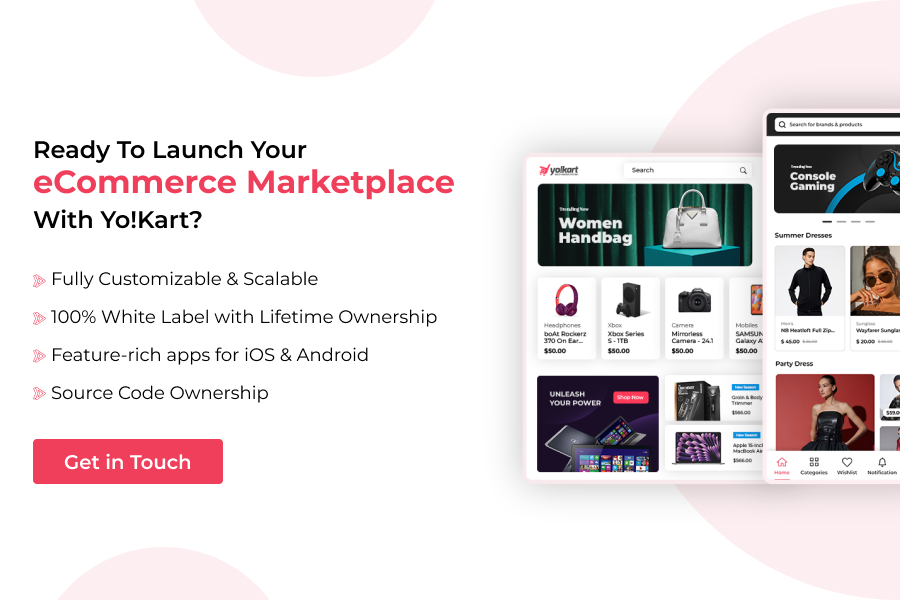How to Create a Multivendor Marketplace for Car Parts & Accessories: Step-by-Step Guide
Published on 09th May, 2025
The automotive aftermarket is booming, with car owners, DIY enthusiasts, and repair shops increasingly turning to online platforms to buy parts and accessories.
According to a report from Fortune Business Insights, the global eCommerce market for automotive parts is expected to reach an impressive $343.13 billion by 2032, up from $116.24 billion in 2025 at a CAGR of 16.7% for the forecast period. Consumers want convenience, variety, and reliability when sourcing parts—needs that a multivendor marketplace can effectively fulfill.
Moreover, building a multivendor marketplace for car parts not only taps into this growing demand but also opens up multiple revenue streams, reflecting a lucrative opportunity for entrepreneurs and businesses to tap into this booming market.
So, in this guide, we will explore the key steps, features, and strategies you need to create a multivendor marketplace for car parts & accessories.
Table of Contents
- Why Choose a Multivendor Marketplace Model for Auto Parts?
- Top Players of the Car Parts Multivendor Marketplace
- Must-Have Features to Create a Multivendor Marketplace for Car Parts
- Steps to Build a Multivendor Marketplace for Car Parts & Accessories
- How does Yo!Kart Help Launch a Car Parts Marketplace Quickly and Cost-Efficiently?
- Conclusion
- FAQs
Why Choose a Multivendor Marketplace Model for Auto Parts?
The multivendor marketplace model allows several independent sellers to list and sell their products under a single domain. Unlike traditional online stores that rely on a single inventory source, multivendor platforms empower sellers to manage their inventory, pricing, and shipping logistics.
Benefits for the Platform Owner:
- Minimal inventory management
- Faster product catalog expansion
- Diverse supplier network
- Streamlined operations
Benefits for Buyers:
- Competitive pricing from multiple vendors
- Access to a broader range of products
- Ratings and reviews for informed decisions
Why It’s Ideal for Car Parts:
- Auto parts vary by make, model, and year—no single vendor can stock everything
- There is a massive range of OEM, aftermarket, and used parts
- Shoppers rely heavily on fitment data and trustworthy sourcing
Top Players of the Car Parts Multivendor Marketplace
Understanding who the current leaders are in the online car parts space can help you benchmark features, performance, and user experience expectations. These platforms have gained popularity by offering reliable service, broad product catalogs, and strong branding.
1. eBay Motors: As one of the most established players in the automotive space, eBay Motors provides a vast marketplace for new, used, and aftermarket car parts. Its key strengths lie in:
- Massive product selection with international reach
- Auction and Buy Now formats
- Seller rating systems for trust building
- Fitment filtering by vehicle year/make/model
Challenges: Limited control over seller quality, generalist user experience, and no niche focus on auto parts.
2. RockAuto: RockAuto has built a strong brand for being a go-to destination for mechanics and DIYers looking for low prices and vast inventory. Key features include:
- Huge catalog of auto parts with exploded diagrams
- Easy vehicle lookup
- Competitive pricing
Challenges: RockAuto operates as a single-seller model and lacks multivendor functionality, which may limit supply variety.
3. CarParts.com: This dedicated auto parts eCommerce platform offers a seamless, consumer-first shopping experience with:
- Modern UX and mobile optimization
- AI-based recommendation tools
- Certified fitment verification system
Challenges: Not a multivendor model; operates as a retailer rather than a marketplace.
4. Amazon Automotive: Amazon’s automotive category has grown quickly thanks to the company’s logistics network and trusted brand. Standout features include:
- Prime delivery for eligible parts
- Verified Fit tool for select models
- Broad exposure for third-party sellers
Challenges: High competition and fees for sellers, limited niche targeting, and a generic interface not tailored to parts-specific use cases.
5. PartSouq: Known for international OEM parts, PartSouq offers a multivendor approach catering to both individual customers and B2B clients. It stands out with:
- OEM and aftermarket listings
- Global shipping
- VIN-based search and ordering
Challenges: Long shipping times for some regions and less presence in North America.
These platforms showcase the strengths and current trends in the automotive eCommerce space, yet they also highlight areas where there is potential for growth and innovation. A strategically designed, well-optimized multivendor marketplace has the opportunity to address these gaps effectively, positioning itself to capture a unique and valuable niche within the market.
Keen to Launch a Car Parts Marketplace Similar to the Ones Mentioned Above?
Must-Have Features to Create a Multivendor Marketplace for Car Parts
Creating a successful multivendor marketplace for car parts requires more than just basic eCommerce functionality. The platform must be specifically engineered to support complex fitment data, vendor diversity, and buyer confidence—especially in a category where precision and compatibility are essential. Let’s explore the expanded, SEO-friendly list of features your platform must include to win over both buyers and sellers.
For Buyers:
- Advanced Vehicle Search Filters: Provide users with intuitive filters by year, make, model, sub-model, trim level, and engine type. This ensures they can quickly narrow down results to compatible products.
- VIN Lookup Tool Integration: A VIN (Vehicle Identification Number) decoder tool automates vehicle recognition and ensures buyers are only shown parts compatible with their exact car, reducing returns and frustration.
- Fitment Validation & Compatibility Warnings: Help buyers avoid costly mistakes by verifying fitment before checkout. Include compatibility notes, diagrams, and alerts when a part might not fit their selected vehicle.
- Part Comparison Engine: Allow side-by-side comparison of parts across multiple vendors—OEM vs aftermarket vs remanufactured—so buyers can assess price, brand, warranty, and customer ratings in one view.
- Multi-vendor Checkout Cart: Let customers add products from different vendors to one cart and complete a single, streamlined checkout process with consolidated tracking.
- Transparent Shipping & Delivery Tracking: Real-time shipping estimates, preferred courier options, and live tracking links enhance the buyer’s trust and experience.
- Ratings and Reviews: Display verified purchase reviews, including whether the part fit as expected. This social proof helps new buyers feel confident about their purchases.
For Vendors:
- Seamless Vendor Onboarding: A streamlined process to simplify account setup, documentation submission, and product listing makes it easy for vendors to get started.
- Bulk Product Upload with Fitment Mapping: Let sellers import large inventories using CSV files that include fitment data (linked to ACES/PIES standards or similar). This streamlines the setup for vendors with extensive catalogs.
- Real-Time Inventory Management: Provide tools for syncing stock levels, updating availability, and managing orders in real-time. Alerts for low inventory help vendors restock proactively.
- Order Fulfillment & Shipping Tools: Enable sellers to manage shipping preferences, print labels, and offer customers multiple delivery options, from local pickup to expedited shipping.
- Vendor Analytics Dashboard: Offer insights into sales performance, best-selling SKUs, return rates, customer satisfaction, and marketplace trends so vendors can optimize their listings.
- Review Management & Response Tools: Let sellers monitor and respond to customer reviews, and request follow-up reviews after successful purchases.
For Admins:
- Customizable Commission Models: Enable admin to apply category-specific commissions, flat fees, or performance-based rates. Flexibility allows for incentives or penalties based on vendor behavior.
- Vendor Approval & Monitoring Tools: Implement manual or automated vendor approval workflows to vet quality and monitor listings to ensure they meet platform standards.
- Content Moderation & Compliance: Use automated tools or human moderation to ensure product listings follow marketplace policies—especially important for used or refurbished auto parts.
- Refund & Dispute Resolution Center: Provide tools for reviewing and resolving disputes, automating refunds, and ensuring fair treatment of both buyers and sellers.
- Marketplace Analytics & Reports: Access high-level data on total sales, vendor performance, product returns, customer acquisition, and more to support data-driven decisions.
Having these advanced, category-specific features in place elevates your car parts marketplace from a basic eCommerce site to a trusted industry platform. Additionally, prioritizing usability, compatibility, and reliability will build long-term loyalty and vendor satisfaction.
Steps to Build a Multivendor Marketplace for Car Parts & Accessories
The automotive aftermarket industry has witnessed consistent growth over the past decade, with consumers increasingly turning to online platforms for car parts, performance upgrades, and vehicle accessories. This shift in buying behavior presents a lucrative opportunity for entrepreneurs looking to build a multivendor marketplace catering to this sector. However, setting up such a platform involves a strategic approach that takes into account product complexity, vehicle compatibility, supply chain logistics, and end-user experience.
Let’s take a look at the essential steps involved to build a multivendor car parts marketplace.
1. Define Your Niche and Identify Your Target Audience
The first and most crucial step is to clearly define your niche. The automotive sector is vast and diverse. You might choose to specialize in aftermarket parts, OEM components, refurbished or used parts, or even niche accessories for electric or classic cars. Some marketplaces focus exclusively on a particular category, like tires, performance parts, or off-road gear.
Equally important is defining your target audience. Are you catering to individual car owners looking to replace worn-out components? Or are you targeting professional mechanics, garages, dealerships, or B2B buyers who require bulk orders and fast deliveries? This clarity will guide everything from platform design and product taxonomy to marketing messaging.
2. Conduct In-Depth Market Research
Once your niche and audience are clear, the next step is understanding the competitive landscape. Market research helps you identify what’s working in existing marketplaces and where gaps exist. Study your competitors—what features do they offer? How do they categorize products? What customer pain points are they failing to address?
You’ll also want to understand pricing models, popular product categories, customer preferences, and current demand trends. Conduct surveys, analyze user reviews, and explore forums where car enthusiasts or mechanics discuss parts and online marketplaces. This data will serve as the foundation for your multivendor car parts platform’s value proposition and user experience.
3. Choose the Right Marketplace Business & Revenue Model
A multivendor marketplace for car parts must have a well-defined business model to remain profitable and sustainable. Common revenue models include:
- Commission-Based: You charge a percentage on every sale made through the platform.
- Subscription-Based: Vendors pay a monthly or yearly fee to list and sell their products.
- Membership Plans: Vendors can be charged a monthly or yearly subscription fee in exchange for exclusive benefits or premium features.
- Advertising: Allowing third-party businesses to promote their services by placing in-app advertisements.
- Hybrid Models: A combination of commission, subscriptions, and listing fees.
The choice of model will also affect how vendors interact with the platform and what incentives you can offer to attract quality sellers.
4. List Down Essential Features and Functional Requirements
Car parts marketplaces are more complex than general eCommerce platforms because users must often find parts based on specific vehicle compatibility. As such, the platform must offer:
- Vehicle-Based Search Filtering (make, model, year, engine specs)
- Advanced Product Categorization for thousands of SKUs
- Vendor Dashboards to manage listings, inventory, and orders
- Inventory Sync and Management
- Real-Time Order Tracking
- Product Comparison Tools
- Ratings and Reviews for sellers and parts
- Secure Payment Gateways with multi-currency support
- Shipping & Returns Integration with courier APIs
- Mobile Optimization for users shopping on smartphones
Furthermore, don’t overlook the admin side—your backend should offer visibility into marketplace performance, vendor metrics, dispute resolution tools, and flexible commission controls.
Build a Feature-rich Multivendor Marketplace for Car Parts & Accessories
5. Focus on User Experience and Interface Design
A seamless, intuitive user experience is key to retaining both buyers and sellers. Since car parts are technical and compatibility-driven, the interface should guide users to relevant results effortlessly. Features like shop by vehicle filters, visual compatibility checks, detailed product specifications, and FAQs or installation guides can greatly improve trust and reduce product returns. Similarly, vendor-side UX should simplify catalog uploads, track performance analytics, and manage orders with minimal effort.
6. Decide Between Custom Development vs. Ready-Made Solutions
This is a pivotal decision. You can either:
- Build from scratch, hiring a development team to create your platform from the ground up, or
- Choose a ready-made multivendor marketplace software that offers the core functionality out of the box.
Custom development gives you full control but demands a high budget, takes months (or years), and requires ongoing maintenance. On the other hand, using a robust, readymade software purpose-built for multivendor marketplaces can significantly reduce time-to-market, cut development costs, and eliminate guesswork.
Among several solutions available in the market, Yo!Kart stands out as a premier multivendor marketplace software to create a multivendor marketplace for car parts & accessories.
7. Launch and Market Your Marketplace Strategically
Once your platform is built and tested, the next critical phase is launching it and ensuring it gains traction. A successful launch doesn’t just mean the site goes live; it means it gains visibility, attracts vendors, and starts generating buyer activity from day one.
Start with a soft launch or beta release. This allows you to onboard a few trusted vendors, test real-world scenarios, gather feedback, and fix any usability issues. It also helps you build early momentum and social proof before a full-scale public launch.
Build a vendor acquisition strategy. Without vendors, your marketplace won’t have the products buyers are looking for. Reach out directly to auto parts dealers, suppliers, and garage owners through email outreach, trade associations, automotive expos, or online classifieds. Offer early-bird discounts or zero commissions for initial sign-ups to incentivize participation.
Simultaneously, focus on customer acquisition. Use digital marketing tactics like:
- Search Engine Optimization (SEO) to appear in organic Google searches
- Google Ads targeting keywords like “buy car parts online” or “brake pads for [car model]”
- Social media marketing, especially on Facebook and Instagram, to target car owners and enthusiasts
- Influencer partnerships with auto YouTubers or car modding channels
- Email campaigns offering launch discounts or limited-time coupons
How does Yo!Kart Help Launch a Car Parts Marketplace Quickly and Cost-Efficiently?
If you’re looking to avoid the complexities and costs of building a platform from scratch, Yo!Kart offers a reliable and scalable solution specifically designed for multivendor eCommerce models. What makes it a strong fit for a car parts marketplace is its flexibility, industry-ready features, and time-saving implementation.
Yo!Kart is not a generic eCommerce script—it’s a full-fledged marketplace solution that comes with built-in modules for vendor onboarding, product filtering, inventory management, real-time order tracking, and customizable business rules. For car parts marketplaces, its ability to support vehicle-specific product filters is particularly valuable.
Moreover, Yo!Kart is highly customizable. Whether you want to modify the interface, adjust the workflow for your niche, or integrate region-specific payment gateways and logistics partners, the platform allows full adaptability. You’re not locked into a rigid system; instead, you get a powerful foundation that evolves with your business.
Key benefits of using Yo!Kart:
- Self-hosted solution with a one-time payment offer
- Lifetime ownership with no recurring costs
- Faster time-to-market compared to custom development
- Lower upfront investment compared to custom development
- Mobile-ready design for today’s on-the-go shoppers
- Highly scalable and customizable
- Inbuilt marketing tools
- Dedicated 1 year free technical support
Book a Free One-on-One Demo Session to Know More About Yo!Kart
Conclusion
Building a multivendor marketplace for car parts and accessories is an ambitious but highly rewarding endeavor. From identifying the right niche to crafting a seamless buyer experience and supporting vendors with the right tools, every step matters. While custom development gives you a blank canvas, it also introduces complexity, cost, and delays.
For a faster, smarter route to market, platforms like Yo!Kart offer an ideal alternative—blending flexibility, cost-efficiency, and all the must-have features needed to thrive in the competitive automotive eCommerce landscape. Whether you’re entering the space for the first time or transitioning from a single-seller model, Yo!Kart can help you go live faster—and scale with confidence.
FAQs
Q 1. Can I start a car parts marketplace without a technical background?
Ans. Yes, especially with software like Yo!Kart that are built to be user-friendly and offer complete support. You can manage vendors, products, and orders through an intuitive admin panel.
Q 2. How is Yo!Kart different from other eCommerce solutions?
Ans. Yo!Kart is a white-label, highly scalable multi-vendor marketplace software tailored for businesses looking to build and scale their online stores. Unlike traditional eCommerce platforms, Yo!Kart provides advanced features such as a built-in multi-vendor system, robust product management tools, integrated payment gateways, and seamless mobile optimization.
With a focus on flexibility, scalability, customizability, and user-friendliness, Yo!Kart can help businesses create a unique, feature-rich multivendor marketplace for car parts & accessories while ensuring ease of use for both sellers and buyers.
Q 3. Can Yo!Kart be scaled as my business grows?
Ans. Absolutely. Yo!Kart is designed to scale seamlessly as your business expands. It supports growth by allowing you to easily increase your vendor base, manage higher traffic volumes, and expand your product catalog without compromising performance. Additionally, it offers multilingual and multicurrency support, making it the perfect solution for expanding into international markets. This enables you to reach a global audience and cater to customers in their preferred language and currency, ensuring a smooth and localized shopping experience.
Q 4. What’s the typical timeline to launch using Yo!Kart?
Ans. The typical timeline to launch a store using Yo!Kart is between 2 to 3 weeks—far quicker than a custom-built alternative. However, this timeframe can vary in case of any customizations or specific requirements for your marketplace.




